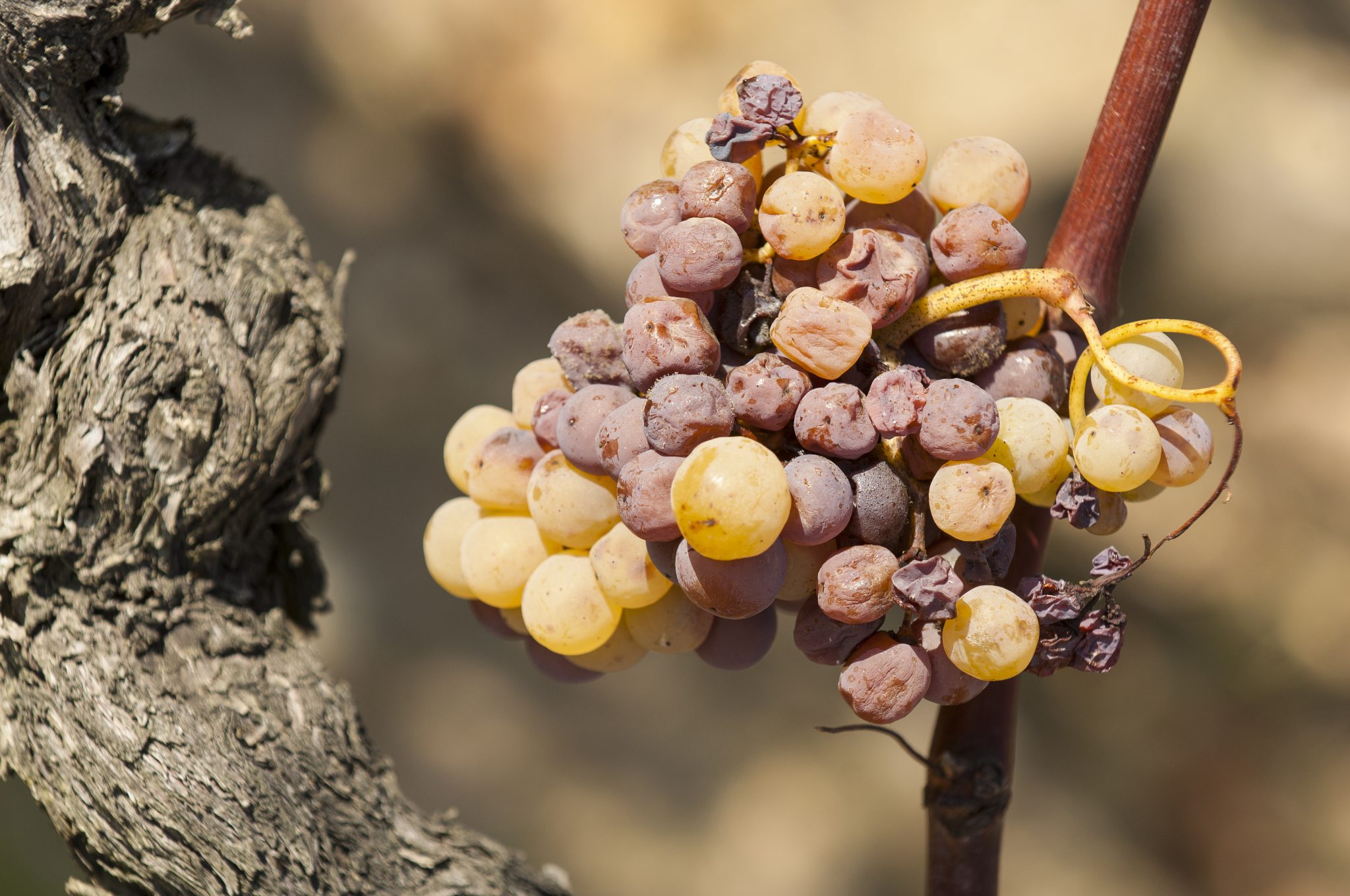Sweet wines are mainly made by encouraging the growth of Botrytis cinerea, a type of fungus that shrivels wine grapes, also known as ‘noble rot’. However, they are other ways to make sweet wine. This blog will guide you through the different method and style of sweet wines, from delicate off-dry to luscious whites.
How do you make sweet wine?
To make a sweet wine, the fermentation is stopped before the yeast converts all sugars into alcohol so the wines retain the natural residual sugar. There are various methods to achieve this.
Removing the yeasts
One way to stop the fermentation is by removing the yeasts. By cooling the temperature, the yeasts go to sleep which stops the fermentation. They are filtered and removed so the wine has residual sugar. Naturally aromatic grapes such as Riesling, Gewurztraminer, Chenin Blanc, Muscat or Torrontes are favoured for this style of wine. Low in alcohol and refreshingly sweet, they are usually off-dry and meant to be drunk in their youth. They are great with spicy food. View our selection.
The noble rot
Noble rot or botrytis cinerea is a type of fungus that shrivels wine grapes. The mould creates filaments in the skin of the grapes which allows the juice inside to evaporate. That process concentrates all the components of the grape, especially sugar and flavours. For the botrytis to take place, the right amount of humidity and warmth must be achieved, which can be tricky. Only a few regions can achieve this and there is no guaranty this will happen every year.
Botrytis spreads sporadically, which means a laborious hand harvest of individual botrytised grapes. Several picking times are necessary to collect the fully infected grapes. Pickers must go into the vineyards four to ten times during October and November, adding a huge cost to the final wine. The shrivelled grapes will have a tiny amount of juice. The concentration of alcohol is so great that it kills the yeasts which stops the fermentation, leaving some residual sugar so the wine is naturally sweet. Botrytis adds complex notes of ginger and beeswax. The best examples are found in Sauternes, Bordeaux in France and Tokaji in Hungary. With age, they will gain opulence and more complexity.
Late harvest
Harvest takes place when the balance between the sugar and acidity levels is optimum, however a grower may wish to wait longer, typically for up to two months after the usual harvest time. When the grapes are left on the vine after they’ve reached their peak ripeness, they become sweeter and start to dehydrate, concentrating the sugar. This is known as Vendange Tardive in Alsace, France and Spatlese in Germany. The wines have both residual sugar and higher alcohol. Aromatic grapes such as Riesling, Gewurztraminer and Chenin Blanc can all deliver great results when late harvested.
Ice wine
As per the late harvest, the grapes are left on the vine but this time until the vine freezes. The grapes are harvested and pressed while still frozen. Originally from Europe (Germany, Austria and Switzerland), this method today is mainly used in Canada. The resulted wines are richly sweet with hints of honey.
Drying the grapes
This process is mainly used in Italy and is known as Passito or Vin Santo, but also in Greece and in France (Vin de Paille). Grapes are partially dried on mats or hung in bunches whether directly in the sun or in a ventilated room to concentrate the sugar. This methods is used for both white and red grapes.
Addition of spirit
This is mainly used to produce Port, Madeira and Sherry, all are fortified with spirits which stops the fermentation. There are drier and sweeter versions of all three. The driest being Fino or Manzanilla sherry. Most are made to be enjoyed after a meal or with cheese or dessert, but the driest styles work well as an aperitif.
The most famous Sweet wine
Sauternes – France
A sweet wine area which lies to the south east of Bordeaux on the left bank of the Garonne, near Langon. The region is made up of five communes including Sauternes, the others being Barsac (the only one other than Sauternes allowed to use its own name), Bommes, Fargues and Preignac. The grape varieties are Semillon which is normally the largest part of any blend, Sauvignon and Muscadelle. The autumn mists rising from the River Ciron encourage the growth of Botrytis cinerea, or ‘noble rot’, on the grapes which penetrates the skins allowing the moisture within to evaporate thus concentrating the sugars. At the same time it imparts its own inimitable flavour. The yields are, as a consequence, low but the wines have a ravishing sweetness matched by a ripe and exhilarating acidity. There are no other wines that can match them anywhere else in the world. The wines of Sauternes were part of the Classification of 1855 (see under ‘Medoc’ for details of this) and include one First Growth, Château Y’Quem. Read more.
Tokaji – Hungary
Hungary, famous for the sweet wine made there, Tokaji Aszú. The grapes used are mainly Furmint, with some Harslevelu and a little Muscat. To make this, the grapes are allowed to stay on the vine for as long as possible, sometimes as late as November, to concentrate the sugar, before being fermented to become the ‘base’ wine. Any that become desicated by Botrytis cinerea, or noble rot, are known as ‘Aszú’ and are put into vats separately, where they are crushed into a paste. The wine maker adds some of this paste to the base wine and a further, slower, fermentation takes place. The quantity of Aszú fruit that is added is measured in ‘Puttonyos’ (literally ‘baskets’ or ‘hods’) with the number, 3 ‘Puttonyos’, 4 ‘Puttonyos, and so on, indicating the sweetness of the wine. There are some dry and semi-dry natural wines made in Tokaj also.
Mosel – Germany
The Mosel valley has a surprisingly warm, continental, climate for a region so far north. Reflected heat from both the river and from the porous slate in which the vines are planted helps ripen the grapes making this one of the finest of all German viticultural regions. The most desirable sites are those which have a south facing aspect, attracting the most sunshine.
Germany produces wines with different level of sweetness. The main quality leavels used for the production of Riesling are as follows:
Spätlese: late harvest, with more natural residual sugar
Auslese: late harvest, high levels of natural sugar, hand selected bunches, sometimes botrytis affected
Beerenauslese: made from very ripe hand selected berries, often botrytis affected, intense and sweet
Trockenbeerelauslese: made from hand selected, shrivelled berries, often botrytis affected. Very intense and sweet
Eiswein: ice wine i.e. from berries that have been frozen on the vine, giving tiny yields but great concentration and sweetness
Monbazillac – France
Sweet wine area in Bergerac in the Dordogne region in south western France, producing intense, sweet wines which, although they are less refined, are similar to Sauternes. The grape varieties used to produce Monbazillac are Semillon, Sauvignon, and Muscadelle which is an important part of the blend. Thanks to the early morning mists that rise from the river Dordogne and its tributaries in autumn, the grapes are affected by botrytis and are concentrated and luscious.


